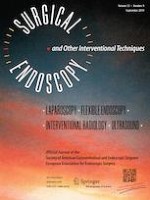Erschienen in:

26.11.2018
Computerized model for objectively evaluating cutting performance using a laparoscopic box trainer simulator
verfasst von:
Amir Handelman, Shani Schnaider, Adva Schwartz-Ossad, Refael Barkan, Ronnie Tepper
Erschienen in:
Surgical Endoscopy
|
Ausgabe 9/2019
Einloggen, um Zugang zu erhalten
Abstract
Background
Laparoscopic box trainer simulator has recently become a tool for assessment of physicians’ surgical and laparoscopic skills, and training using such a simulator has been incorporated into the curricula of surgery syllabus. With the increased use of box trainer simulators, there is a great need for obtaining reliable and objective evaluations of the trainees’ performances. Here, we introduce an automated tool for assessing laparoscopic cutting performance by using image-processing algorithms.
Methods
Twenty-seven interns specializing in the fields of gynecology, urology and general surgery participated in 4–6 training sessions, in which each trainee cut a circular patch positioned inside a low-cost laparoscopic box trainer simulator. The trainees’ performances were analyzed using software that we developed. The analysis of the trainees’ performances was based upon quantitative measurements of the following four parameters obtained in each training session: standard deviation, circle-cutout area, skewness, and number of peaks. We believe that high performance in terms of a combination of the four parameters provides a reliable measure of good laparoscopic skills, and therefore we developed the software so as to generate, for each session, a score of a trainee’s laparoscopic circle-cutout performance that results from achievements related to the four parameters in combination.
Results
On average, the total score of experienced interns was higher than the total score of inexperienced interns. Also, some improvement from session-to-session in the scores of novice trainees was detected.
Conclusions
Our proposed scoring system, which is based on various image-processing algorithms, can evaluate cutting performances of trainees and classify residents by their experience. This allows each trainee to improve his/her performance by analyzing errors indicated by our software.